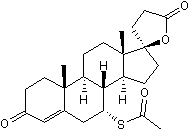Progesterone R B/NR3C3 Products
The progesterone Receptor (PR; NR3C3) is a member of the steroid receptor superfamily which binds progesterone. The progesterone receptor is expressed in uterus, ovary, vagina, fallopian tubes and breast. Progesterone receptors play a central role in diverse reproductive events associated with the establishment and maintenance of pregnancy, alveolar development in the breast, and sexual behavior. Two isoforms of the progesterone receptor have been identified, progesterone receptor-A (PR-A) and progesterone receptor-B (PR-B), 94 and 114 kDa in size, respectively.
The B progesterone receptor (PR-B), or long form, is 933 amino acids (aa) in length. Progesterone receptor-A (PR-A) utilizes a different start site that shortens the N-terminus by 164 amino acids. The N-terminus in both progesterone receptor isoforms is rich in serine that is phosphorylated in response to hormone binding. In the absence of progesterone, few receptor molecules are phosphorylated at Serine 190 (S190). Progesterone increases this number two-fold, providing evidence for hormone stimulation. It has been shown that the two progesterone receptor isoforms can form homodimers as well as heterodimers.
39 results for "Progesterone R B/NR3C3" in Products
39 results for "Progesterone R B/NR3C3" in Products
Progesterone R B/NR3C3 Products
The progesterone Receptor (PR; NR3C3) is a member of the steroid receptor superfamily which binds progesterone. The progesterone receptor is expressed in uterus, ovary, vagina, fallopian tubes and breast. Progesterone receptors play a central role in diverse reproductive events associated with the establishment and maintenance of pregnancy, alveolar development in the breast, and sexual behavior. Two isoforms of the progesterone receptor have been identified, progesterone receptor-A (PR-A) and progesterone receptor-B (PR-B), 94 and 114 kDa in size, respectively.
The B progesterone receptor (PR-B), or long form, is 933 amino acids (aa) in length. Progesterone receptor-A (PR-A) utilizes a different start site that shortens the N-terminus by 164 amino acids. The N-terminus in both progesterone receptor isoforms is rich in serine that is phosphorylated in response to hormone binding. In the absence of progesterone, few receptor molecules are phosphorylated at Serine 190 (S190). Progesterone increases this number two-fold, providing evidence for hormone stimulation. It has been shown that the two progesterone receptor isoforms can form homodimers as well as heterodimers.
| Reactivity: | Human |
| Details: | Mouse IgG1 Monoclonal Clone #CL8721 |
| Applications: | IHC, ICC/IF |
| Reactivity: | Human |
| Details: | Mouse IgG1 Monoclonal Clone #CL8721 |
| Applications: | IHC, ICC/IF |
| Reactivity: | Human |
| Details: | Mouse IgG1 Monoclonal Clone #CL8721 |
| Applications: | IHC, ICC/IF |
| Reactivity: | Human |
| Details: | Mouse IgG1 Monoclonal Clone #CL8721 |
| Applications: | IHC, ICC/IF |
| Reactivity: | Human |
| Details: | Mouse IgG2a Monoclonal Clone #H5344 |
| Applications: | WB, IHC, IP, DirELISA |
| Reactivity: | Human |
| Details: | Mouse IgG2b Monoclonal Clone #569012 |
| Applications: | WB, IHC, ICC |
Endogenous progesterone receptor agonist
| Chemical Name: | Pregn-4-ene-3,20-dione |
| Purity: | ≥99% (HPLC) |
Progesterone and glucocorticoid receptor antagonist
| Alternate Names: | RU 486,RU 38486 |
| Chemical Name: | (11β,17β)-11-[4-(Dimethylamino)phenyl]-17-hydroxy-17-(1-propynyl)-estra-4,9-dien-3-one |
| Purity: | ≥99% (HPLC) |
Progesterone receptor membrane component 1 (Pgrmc1) ligand
| Chemical Name: | cis-2-[[1-(4-Chlorophenyl)-1H-tetrazol-5-yl]thio]-1-(1,2,3,4,4a,9b-hexahydro-2,8-dimethyl-5H-pyrido[4,3-b]indol-5-yl)-ethanone |
| Purity: | ≥97% (HPLC) |
Synthetic progesterone analog
| Chemical Name: | 17-(Acetyloxy)-6-methylpregna-4,6-diene-3,20-dione |
| Purity: | ≥98% (HPLC) |
Mineralocorticoid receptor antagonist
| Alternate Names: | SC 9420,Aldactone |
| Chemical Name: | (7α,17α)-7-(Acetylthio)-17-hydroxy-3-oxopregn-4-ene-21-carboxylic acid γ-lactone |
| Purity: | ≥98% (HPLC) |
| Reactivity: | Human |
| Details: | Mouse IgG1 Monoclonal Clone #CL8721 |
| Applications: | IHC, ICC/IF |
| Reactivity: | Human |
| Details: | Mouse IgG1 Monoclonal Clone #CL8721 |
| Applications: | IHC, ICC/IF |
| Reactivity: | Human |
| Details: | Mouse IgG1 Monoclonal Clone #CL8721 |
| Applications: | IHC, ICC/IF |
| Reactivity: | Human |
| Details: | Mouse IgG1 Monoclonal Clone #CL8721 |
| Applications: | IHC, ICC/IF |
| Reactivity: | Human |
| Details: | Mouse IgG1 Monoclonal Clone #CL8721 |
| Applications: | IHC, ICC/IF |
| Reactivity: | Human |
| Details: | Mouse IgG1 Monoclonal Clone #CL8721 |
| Applications: | IHC, ICC/IF |
| Reactivity: | Human |
| Details: | Mouse IgG1 Monoclonal Clone #CL8721 |
| Applications: | IHC, ICC/IF |
| Reactivity: | Human |
| Details: | Mouse IgG1 Monoclonal Clone #CL8721 |
| Applications: | IHC, ICC/IF |
| Reactivity: | Human |
| Details: | Mouse IgG1 Monoclonal Clone #CL8721 |
| Applications: | IHC, ICC/IF |
| Reactivity: | Human |
| Details: | Mouse IgG1 Monoclonal Clone #CL8721 |
| Applications: | IHC, ICC/IF |
| Reactivity: | Human |
| Details: | Mouse IgG1 Monoclonal Clone #CL8721 |
| Applications: | IHC, ICC/IF |
| Reactivity: | Human |
| Details: | Mouse IgG1 Monoclonal Clone #CL8721 |
| Applications: | IHC, ICC/IF |
| Reactivity: | Human |
| Details: | Mouse IgG1 Monoclonal Clone #CL8721 |
| Applications: | IHC, ICC/IF |

![Immunohistochemistry-Paraffin: Progesterone R B/NR3C3 Antibody [NBP3-21167] - Immunohistochemistry-Paraffin: Progesterone R B/NR3C3 Antibody [NBP3-21167] -](https://resources.bio-techne.com/images/products/nbp3-21167_mouse-progesterone-r-b-nr3c3-mab-cl8721-4520231546338.jpg)







